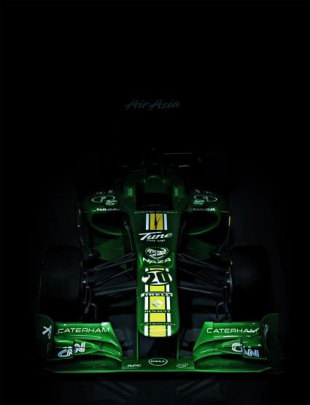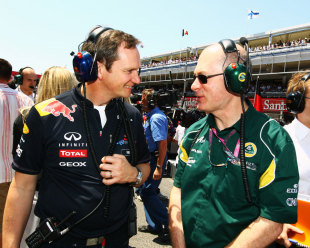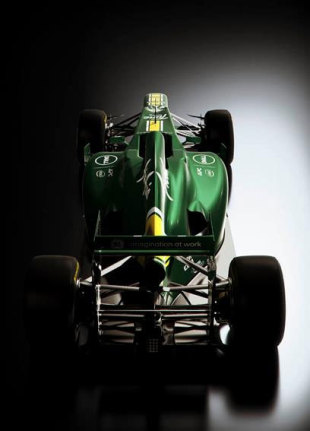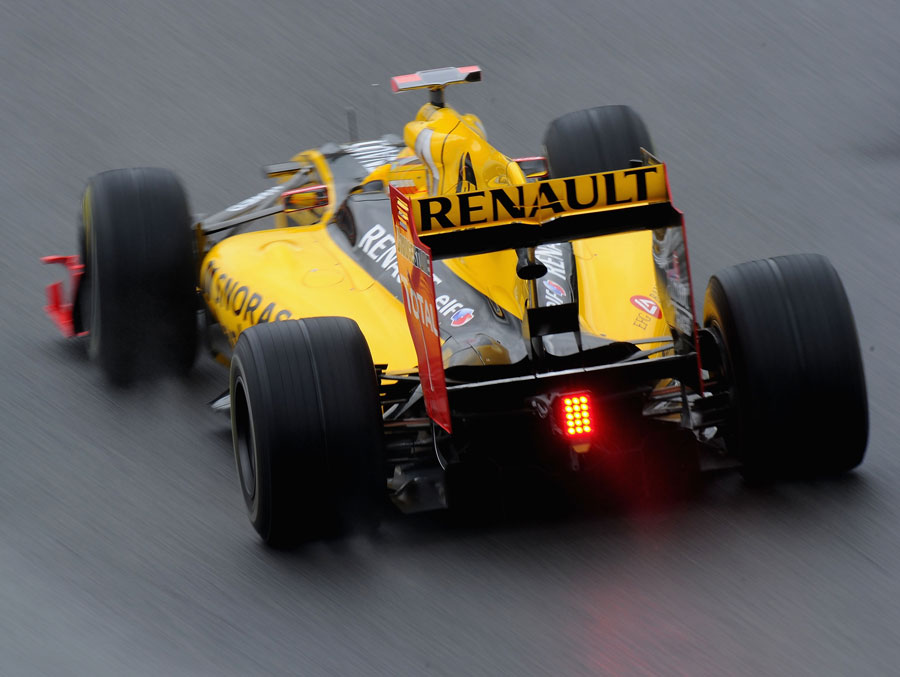Caterham technical director Mark Smith talks to ESPNF1 about the new CT01, the challenges ahead for the team and any potential driver line-up change

- News:
-
New Caterham 'an evolution' - Smith
- News:
-
Fernandes targets point in 2012
- News:
-
'It's time we moved forward' - Gascoyne
- News:
-
Caterham launches the CT01
- Teams:
- Caterham
We've seen the new car now, how pleased are you with the CT01?
It's obviously always difficult to answer that question until the car's run and we know where we are relative to the other teams. But the thing that does please me and that I'm contented with is that it's definitely the best job that we could have done with resources that we have, and I think that's probably as much as we can say right now. I don't look at it and think we missed an opportunity to do this or that, I think that it's a good all-round step forward.
You've only been working with the team since May of last year so this is your first car for Caterham. Is it a big departure from last year's car?
No it's not, for a number of reasons. One, obviously the engine partner and the transmission partner remain the same, so that gives some continuity there and the hydraulic system is all part of that. It's an evolution but in many respects it has moved forward and I think that the main reason for that is - whilst I wasn't here when last year's car was designed so I can only go on things that I'm told - I think there were quite a lot of people here for whom it was the first time through the whole process of being involved in the design and build of a Formula One car, certainly the design of the car. So that's a bit of a baptism of fire. There were obviously a few experienced guys, and it was a smaller group. So what we've had an opportunity to do this time around - because the numbers are slightly higher in terms of designers and aerodynamicists and R&D engineers - is we've had the opportunity to just go further with every aspect of the design. So whether for example it's the front suspension, we've had more opportunity to refine the solution that we eventually take to the car in terms of their efficiency. So every part on the car I'd like to think is more efficient in terms of doing its job, which normally means probably air ratios, stiffness to weight or strength to weight. And I think that's what comes with evolution. Because the team was a very new team and in all honesty last year's car was the first car that designed at Hingham, it's been relatively easy for the design group as a whole to take things forward to a fairly reasonable extent.
You were under a bit more pressure this year because the crash tests had to be passed before testing. When did CT01 pass its crash tests?
Before Christmas, I can't remember the exact date but we had them all cleared before Christmas which was a big bonus really because it's a very fine line between success and failure with the majority of those tests. You go through a process of starting off with one or two solutions for any of the tests - let's say the side impact test - perhaps two or three different configurations. You go and do some preliminary impact testing and then start to filter down your solutions, and then you're developing those as you go along to try and obviously keep weight to a minimum yet pass the tests. So when you eventually do go to the tests with the real impact structures on the real chassis you've already done some fundamental work with them on aluminium plates and then dummy chassis sides for instance. But there is absolutely no guarantee that even if you've had very successful pre-tests that you'll pass the final tests. The line is very fine, the structures do have some variants; two identical parts there will be a little bit of scatter on strength and so on. So it would have been very easy to have gone in to the Christmas break having to rework two or three of those, so the fact that we didn't helped a lot; it allowed us then to focus on the remaining parts of the car that still needed to be designed and issued.

Do you think that the crash tests will catch any of the other teams out at all?
I'm inclined to think not. I suspect there will be some tests that are failed because that's perfectly normal but I think the way it's worked out this year - unless the teams are going very late with their official homologation tests, if anybody's going very late then it does have the potential to catch people out - I imagine the majority of people would, simply because of the requirements to have your chassis finished in time for not just the first test but all done and dusted and homologated and built up for the first race, people will probably go earlier rather than later I would think. And because they go earlier - I think a lot of teams were doing impact tests as we were before Christmas - you've got more opportunity to resolve them. The first test is 7th of February so it kind of leaves the whole of January there to fix any issues. So my belief is it will probably be less fraught that it has in the past where we've all heard rumours of the odd team occasionally in the time period a few days before the race still having to pass the test.
We've got to mention the front end and the nose; obviously it's not for an aesthetic purpose but can you explain why it's been designed the way it has and what the effect is on the rest of the car?
The reason for the - for want of a better word - the step between the top surface of the nose and the top surface of the chassis is a regulation driven thing. I suspect we won't be the only team that comes up with that solution. Effectively the top surface of the nose, the height of the top of the nose is limited now by regulation to be lower than the top surface of the chassis. Now it's fairly clear that there is always the option to bring the top of the chassis down to the maximum height of the top of the nose so that you would see a completely aligned upper surface of nose and chassis. We could do that, the reason we haven't done that and I suspect the reason that a few other people won't do that is we are trying to maintain the best flow of air that goes under the chassis at the front for aerodynamic purposes.
Does that mean you're focusing more on the front of the car? Or maybe the rear; is there a strong point to this car?
Not really, I don't think there's been a focus on one area over or at the expense of another. And in all honesty, that solution that we've adopted - although you end up with that discontinuity on the top surface - it has not had a significant influence on the aerodynamics of the whole of the car. I think that is because we've maintained nominally the same chassis height and therefore the same underfloor body flow.
One of the other things that is completely new for the car is that you've got KERS for the first time. It's the Red Bull packaged KERS; was it a challenge packaging it? Red Bull obviously went smaller with its packaging last year and it caused it a few issues but has that made it easier for you?
It hasn't been a particular challenge because I think the challenges have been met by Red Bull in terms of the way in particular the batteries are packaged. By virtue of taking the gearbox as a customer we have the same basic packaging there so all of the issues that Red Bull had in terms of developing the system we ultimately are benefitting from.

Does it concern you that at this time last year Red Bull did have a few issues with the KERS, especially with it being a new technology for yourselves?
No I don't have any strong concerns over that, really because it's a system that Red Bull developed throughout the course of last season and I think it was apparent by observation from outside that they did initially issues which of course they resolved and it's encouraging obviously to know that the system was considered sufficiently valuable to resolve those problems so that it is an integral part of the car. So no, we don't have any significant concerns. Obviously our car is different to their car and the underbody temperatures won't be identical so we do have to keep an eye on those things, particularly in the first three tests because there will be differences by virtue of just general packaging. But fundamental issues, no we don't have.
Last year we say both ends of the design scale; Renault went very aggressive with its front-exiting exhausts but then couldn't develop the car, whereas Force India were a bit more conservative with its car but then had a lot of development potential throughout the year. Where would you rank this car in that scale?
This car, I would describe it as certainly not technically adventurous. We've tried to design a car that has made the progress in terms of all the basic side solutions that I referred to earlier; something that's lighter, has more efficient structures, that addresses any issues that we may think we had aerodynamically. Obviously aero-wise we're all trying to increase the downforce of the car, so that was one of our key targets. I think it's a fairly straightforward car, apart from the KERS. The KERS is a fairly complex solution and it's a very nicely packaged solution. The rest of the car I think is sound, logical design.
Do you have many upgrade packages planned during the pre-season?
We will have some aero parts that will be run for the final test going forward to the first race which is basically front wing and bodywork; rear bodywork.
Is there a significant impact from the in-season test in terms of how you plan to develop the car?
The in-season test obviously will be the first time we have an opportunity to run things after the first races following the pre-season tests. If I'm perfectly honest with you we do not have a specific update that we are targeting for that test. We will just work flat out now in the tunnel going forward to see what package we can put together and then that will go through the due consideration of bang for buck so to speak.

There's been a bit of speculation over the driver line-up for this year; do you have testing schedules ready for both drivers, Heikki and Jarno?
The testing schedule, what we have is basically a test objectives document which is a fairly conventional routine document in terms of 'we have three tests, how do we plan to use each of those tests?' Obviously as you said yourself KERS is new to us, so there's a lot of work we know we're going to have to cover there. So there is a basic programme outlined for each of the tests but it's not dependent on drivers in anyway.
So theoretically if there was a driver change it wouldn't affect the development plan of the car?
It wouldn't change the test outline no.
Is there likely to be a change?
I have no idea.
Finally then, obviously this is your first full year with the team; how excited are you by the project and the year ahead?
Very much so. Coming back to something I said earlier I personally think that everybody can take some pride in this being - as I consider it - the best job that we could have done with all of the resources at our disposal. That's the first thing to say, I don't think we'll look back and think 'well we should have done this or we should have done that'. You never know, when we see other cars perhaps that will be the case but I'm quite happy with that. I probably, with age I suppose, have become very wary of making any predictions so I don't. What I personally want to try and achieve is to reduce the gap to the two or three teams who were immediately ahead of us last year by the time we get to race one, and to be able to keep developing so that we eliminate that gap, hopefully by the mid-point of the season so that we can be racing on merit with those guys. Anything more than that would be a bonus because given the short duration of this team so far - it's still a relatively immature team - if we could achieve that I think we would have done a good job.
Chris Medland is assistant editor at ESPNF1
© ESPN Sports Media Ltd.
 Chris Medland is assistant editor at ESPNF1 Chris Medland, who in his youth even found the Pacific GPs entertaining, talked his way in to work at the British Grand Prix and was somehow retained for three years. He also worked on the BBC's F1 output prior to becoming assistant editor ahead of the 2011 season
Chris Medland is assistant editor at ESPNF1 Chris Medland, who in his youth even found the Pacific GPs entertaining, talked his way in to work at the British Grand Prix and was somehow retained for three years. He also worked on the BBC's F1 output prior to becoming assistant editor ahead of the 2011 season

